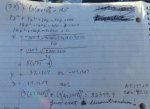allegansveritatem
Full Member
- Joined
- Jan 10, 2018
- Messages
- 962
Here is the problem:

Here is how I am trying to set it up:

I am aware that this is not exactly the way to go--I have already tried it. But is it in the ballpark at all? Obviously I am treating this as a hypotenuse situation. For one thing, the problem that came before was solved hypotneusely, so to speak. The idea governing the above equation is: If distance = rate over time, then letting x = rate of cycle and x+10= rate of car, what we have is the distance each covered divided by the time it took squared will = the hypotenuse divided by time (squared). Ain't quite right but does it even make sense?
Here is how I am trying to set it up:
I am aware that this is not exactly the way to go--I have already tried it. But is it in the ballpark at all? Obviously I am treating this as a hypotenuse situation. For one thing, the problem that came before was solved hypotneusely, so to speak. The idea governing the above equation is: If distance = rate over time, then letting x = rate of cycle and x+10= rate of car, what we have is the distance each covered divided by the time it took squared will = the hypotenuse divided by time (squared). Ain't quite right but does it even make sense?

